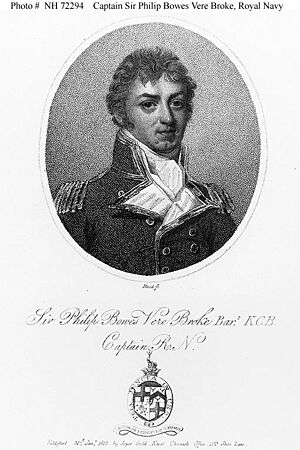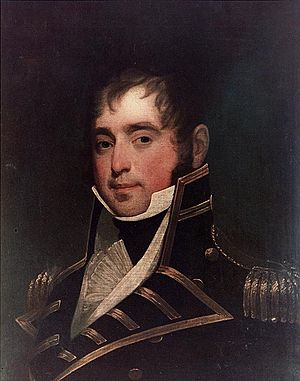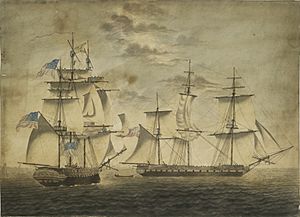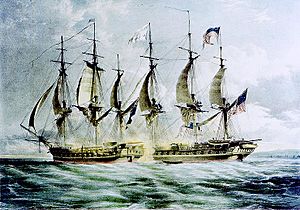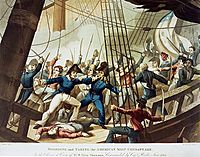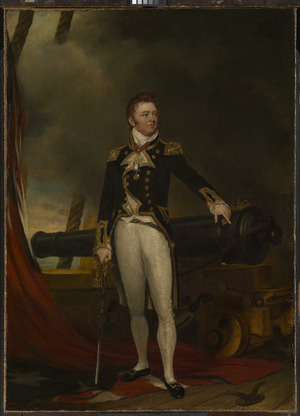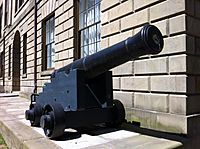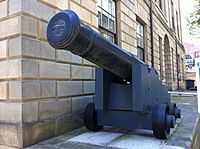Capture of USS Chesapeake facts for kids
Quick facts for kids Capture of USS Chesapeake |
|||||||
|---|---|---|---|---|---|---|---|
| Part of the War of 1812 | |||||||
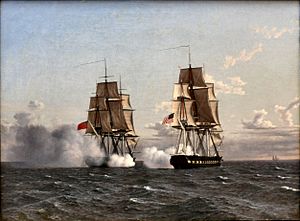 Battle between the English [sic] frigate Shannon and the American frigate Chesapeake, Christoffer Wilhelm Eckersberg (1836) |
|||||||
|
|||||||
| Belligerents | |||||||
| Commanders and leaders | |||||||
| Strength | |||||||
| 1 frigate | 1 frigate | ||||||
| Casualties and losses | |||||||
|
|
||||||
The capture of USS Chesapeake was a famous sea battle. It happened on June 1, 1813, during the War of 1812. The British Royal Navy frigate HMS Shannon fought the American frigate USS Chesapeake.
The battle was short but very fierce. The British ship captured the Chesapeake. This was the only time in the war that two frigates of similar strength fought without one side having a big advantage.
At Boston, Captain James Lawrence took command of the Chesapeake. On June 1, he sailed out to meet the HMS Shannon. The Shannon was waiting nearby, led by Captain Philip Broke. Broke had sent a written challenge to the Chesapeake's commander. But the Chesapeake sailed before the message arrived.
The Chesapeake was badly damaged during the fight. Its steering wheel was shot away, making it hard to control. Captain Lawrence was badly hurt. He was carried below deck. His last words were, "Don't give up the ship!" But the British boarding party quickly took over the ship. The battle lasted only about ten to fifteen minutes. During this time, 226 men were killed or wounded. Captain Broke of the Shannon was also seriously injured, but he survived.
The Chesapeake and its crew were taken to Halifax, Nova Scotia. The American sailors became prisoners of war. The ship was repaired and joined the Royal Navy. Later, in 1819, it was sold and taken apart in Portsmouth, England. Some of its wood was used to build the Chesapeake Mill in Wickham. You can still visit this mill today. The Shannon lasted longer, being taken apart in 1859.
Contents
Getting Ready for Battle
Captain Broke's Training Methods
Captain Philip Broke was the commander of the HMS Shannon. He was very good at training his crew. He made many improvements to his ship's cannons. He added special sights to the guns to help aim better. He also marked the gun carriages so they could be leveled correctly. This helped the cannons fire straight, even if the ship was leaning.
Broke also trained his crew to an amazing level. They often practiced firing at targets like floating barrels. These drills were often competitions. Crews would race to see who could hit the target first. He even made them practice firing "blindfolded." They had to aim only by directions, without seeing the target themselves. This was a very early form of aiming guns from a central spot.
Besides gunnery drills, Broke prepared his crew for many situations. For example, he would pretend the ship was under attack. He would see how his crew would defend it. They also practiced a type of sword fighting called 'singlestick'. This used wooden sticks instead of real swords. It helped the crew become quick and skilled with their hands.
Captain Lawrence's Challenges
Captain James Lawrence of the United States Navy had just won a battle. He had defeated the British ship HMS Peacock. Because of this victory, he was promoted to captain. He was then ordered to command the USS Chesapeake. But he didn't really want this ship. He had hoped for a larger frigate, the USS Constitution.
When Lawrence arrived in Boston, he found problems. Most of the Chesapeake's old crew had left. They had argued about prize money. New sailors had replaced them. These new sailors were good, but they hadn't worked together much. They needed time to become a strong fighting team. Lawrence had fought the British before, and their gunnery had been poor. This made him too confident about facing the Shannon.
The Challenge Is Sent
Captain Broke wanted to fight one of the American frigates. American ships had won several battles against the Royal Navy. The USS President had already escaped from Boston. The USS Constitution was being repaired. But the Chesapeake seemed ready to sail. So, Broke decided to challenge the Chesapeake to a one-on-one battle.
While waiting, the Shannon captured some American ships. Broke burned most of these ships. He wanted to keep his highly trained crew together for the battle. He sent a message to Captain Lawrence, inviting him to fight. Broke had even sent another British ship, the Tenedos, away. He hoped this would make the odds seem fairer and encourage the Americans to come out.
Broke finally sent a written challenge. He was copying Captain Lawrence. Earlier in the war, Lawrence had challenged a British ship to a fight. But that offer had been turned down.
The Chesapeake seems ready for sea. I ask you to meet the Shannon with her, ship to ship. Let's see which flag wins. The Shannon has 24 guns on its side. It has 18-pounder guns on its main deck and 32-pounder carronades on its upper decks. We have 300 men and boys. I am not just being proud. I believe this battle will help my country. I am sure you feel the same. Your small navy can only help your country by winning fair fights. Please reply quickly. We are low on food and water, and cannot stay here long.
Captain Lawrence never actually received Broke's letter. But it wouldn't have mattered. Lawrence planned to sail the Chesapeake as soon as the weather was good. He didn't seem to think about whether challenging a British frigate was good for his country. The USS President had left to attack enemy trade ships, which was important for the U.S.
Half of the Chesapeake's officers and a quarter of its crew were new. Lawrence had only been in command for a short time. He had practiced with the cannons twice. He even created a bugle call to tell his crew to board an enemy ship. But the only person who could play the bugle was a young assistant. Lawrence was sure he would win. He wrote two quick notes. One was to the Secretary of the Navy, saying what he planned to do. The other was to his brother-in-law, asking him to care for his family if he died.
People in Boston were excited. They expected Captain Lawrence to win. They even set aside space at the docks for the captured British ship. They also planned a big victory party. As the Chesapeake sailed out, crowds gathered on hills to watch the fight. Many people even went out in boats to follow the ship.
The HMS Shannon had been at sea for 56 days. It was running low on supplies and was worn down. It was at a disadvantage against the Chesapeake, which was fresh from port. A boat was sent with Broke's challenge. But before it reached shore, the Chesapeake was seen sailing out. It was flying three American flags. It also had a large white flag that said 'Free Trade and Sailor's Rights'.
The Shannon had 276 officers, sailors, and marines. It also had some recaptured sailors, Irish laborers, and young boys. Broke had trained his gun crews to fire accurately at the enemy ship's hull. This was meant to kill the enemy gun crews. Lawrence, however, was confident in his ship. It had more crew members. American victories before this made him expect success. Just before the battle, the American crew cheered loudly.
The two ships were very similar in size and power. The USS Chesapeake had 28 18-pounder long guns, just like the HMS Shannon. Their deck lengths were about the same. The main difference was the number of crew: Chesapeake had 379 men, while Shannon had 330.
| HMS Shannon | USS Chesapeake | |
|---|---|---|
| Length (main deck) | 150 ft 2 in (45.77 m) | 151 ft 0 in (46.02 m) |
| Width | 39 ft 11 in (12.17 m) | 40 ft 11 in (12.47 m) |
| Weight | 1065 tons | 1135 tons |
| Crew | 330 men | 379 men |
| Weapons | 28 × 18-pounder long guns 20 × 32-pounder carronades 1 × 18-pounder chase gun |
* Broke used smaller guns (6-pounder and 12-pounder carronade) so younger midshipmen and boys could practice firing them.
The Battle Begins
Cannon Fire Exchange
As the American ship came closer, Captain Broke spoke to his crew. He told them, "Don't waste any shots. Aim every one. Stay calm. Work steadily. Fire at her decks. Don't try to break her masts. Kill the men, and the ship is yours."
The two ships met at 5:30 in the afternoon. This was about 20 miles east of Boston Light. The Shannon looked old and worn from its long time at sea. This made it seem like an easy opponent. A sailor on the Shannon asked Broke if they could fly three flags like the Chesapeake. Broke said, "No, we've always been a humble ship." The Shannon waited for the Chesapeake to fire first. The Chesapeake also did not try to fire along the Shannon's length. British officers praised Lawrence for his bravery.
The ships started firing just before 6:00 PM. They were about 35 meters apart. The Shannon hit first. It struck the Chesapeake with two cannonballs and a bag of musket balls. The Chesapeake was moving faster. As it passed the British ship, the Shannon's accurate fire caused heavy damage. The American gun crews at the front of the ship suffered the most. However, the American crew fought back well. Many of their shots hit the water or the Shannons lower hull, causing little damage. But American carronade fire damaged the Shannons ropes and sails.
Captain Lawrence realized his ship was going too fast. He ordered a small turn to slow down. Just as the Chesapeake began this turn, it lost control. More accurate British fire hit the ship. The men steering the Chesapeake were killed. The ship's steering wheel was shot away. Surviving American gun crews did hit the Shannon. American carronade fire swept across the Shannon's front deck. It killed three men and damaged a gun.
At the same time, the Chesapeake's fore-topsail ropes were shot away. Its sail dropped, and the ship turned into the wind. It lost its forward speed and started moving backward. The back-left side of the Chesapeake hit the Shannons right side. The Chesapeake was caught by one of the Shannons anchors. A British officer tied the two ships together. He lost an arm doing so.
The Chesapeake was now stuck against the Shannon. Few of its guns could fire at the British ship. The Chesapeake's back was exposed to heavy fire. Earlier, Shannons guns had destroyed the Chesapeakes front gun crews. Now, the back of the ship was hit hard. The situation got worse when a small barrel of musket cartridges exploded. When the smoke cleared, Broke ordered his men to board the Chesapeake. Captain Lawrence also ordered his men to board. But the bugler, William Brown, was scared and didn't sound the call. Only those near Lawrence heard him. By this time, Lawrence was the only officer left on the upper deck. He was badly wounded by musket fire. As he was carried below, he called out, "Tell the men to fire faster! Don't give up the ship!"
The British Board the Ship
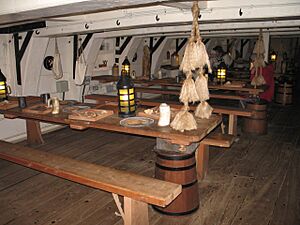
The British boarding party was well organized. Captain Broke led about twenty men onto the Chesapeake. Two British officers were killed as they crossed over. But the rest made it onto the ship. There were no American officers left on the upper deck to fight back.
The main deck of the Chesapeake was almost empty. The surviving American gun crews had either gone to board the enemy or had hidden below. Two American officers managed to fire two of the back cannons at the Shannon.
Lieutenant Ludlow, an American officer, had been wounded. He returned to the upper decks and gathered some American sailors. They launched a counter-attack. They pushed the British back for a short time. But more British soldiers arrived. Ludlow was fatally wounded by a sword. The Americans were pushed back again. An Irish sailor from the Shannon charged into the Americans, shouting in Gaelic. The Americans were driven back because they had no officers to lead them. Many ran below deck for safety.
Fighting also happened in the ship's tops (platforms on the masts). Sharpshooters fired at each other and at sailors on the decks below. British marksmen stormed the Chesapeakes fore-top and killed all the Americans there. Then, the wind pulled the two ships apart. The Chesapeake swung around the Shannons front. This left the fifty British boarders stranded on the Chesapeake. But organized resistance on the American ship had almost stopped.
Broke himself led a charge against some Americans on the front deck. Three American sailors attacked him. He killed the first. The second hit him with a musket, stunning him. The third cut open his head with a sword, knocking him down. Before the sailor could finish him, a British Marine stabbed the American. Shannons crew rushed to defend their captain. They took the front deck, killing the remaining Americans. Broke was dizzy and weak. His head was bandaged. One of Shannons lieutenants thought Broke's attackers might have been British deserters. Deserters faced the death penalty, so they might have fought desperately. Meanwhile, another British officer tried to raise the British flag on the Chesapeake. But sailors on the Shannon misunderstood and accidentally shot him.
The Chesapeake Is Captured
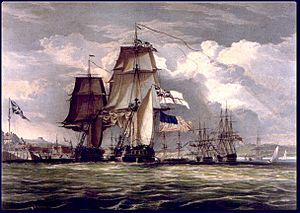
The British had cleared the upper decks. Most of the Chesapeake's crew had hidden below. A shot from below killed a British marine. The angry British crew started firing through the hatchway at the Americans. A British officer, Lieutenant Charles Leslie Falkiner, stopped them. He threatened to shoot anyone who kept firing. He demanded that the Americans send up the man who killed the marine. He told them the Chesapeake was captured. He said, "We have three hundred men aboard. If there is another act of hostility you will be called up on deck one by one – and shot." Falkiner was given command of the captured Chesapeake.
Soon after the Chesapeake was secured, Broke fainted from blood loss. He was taken back to the Shannon to be treated.
The battle lasted only ten minutes by Shannon's log, or eleven minutes by a lieutenant's watch. Broke said fifteen minutes in his official report. The Shannon lost 23 men killed and 56 wounded. The Chesapeake lost about 48 killed, including many officers, and 99 wounded. The Shannon was hit by 158 projectiles. The Chesapeake was hit by 362. The Americans had been hit by 44 cannonballs, while the British had received 10 or 11. Even before being boarded, the Chesapeake had lost the gunnery fight badly.
A large barrel of lime was found open on the Chesapeake's front deck. Some British sailors claimed it was meant to be thrown into their eyes. But historians say lime was kept on ships as a disinfectant. It was probably left on deck by accident.
After the Battle
After the victory, a British prize crew took over the Chesapeake. The American prisoners were restless. So, some of their leaders were moved to the Shannon in leg-irons. These irons had been brought aboard the Chesapeake for British prisoners. The rest of the American crew became quiet. The British cut holes in the main deck. They pointed two 18-pounder cannons, loaded with grapeshot, at the Americans below.
The Shannon, now commanded by Lieutenant Provo Wallis, took its prize into Halifax. They arrived on June 6. As the two frigates entered the harbor, other naval ships cheered. Bands played music. The 320 American survivors were sent to a prison camp on Melville Island. The Chesapeake was taken into British service and renamed HMS Chesapeake. It was used to carry prisoners from Melville Island to Dartmoor Prison in England. Many officers were allowed to leave prison on parole. But some started a riot during a patriotic song about the Chesapeake's defeat. After that, parole rules became stricter.
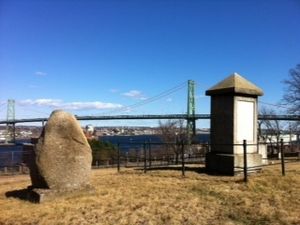
This was the first major British naval victory in the War of 1812. It greatly boosted the Royal Navy's morale. The Shannon sailed to England on October 4, carrying the recovering Captain Broke. They arrived in Portsmouth on November 2. Lieutenants Wallis and Falkiner were promoted. Broke was made a Baronet (a type of knight). He also received awards and money. Captain Lawrence was buried in Halifax with full military honors. Six British Naval Officers helped carry his coffin.
The Chesapeake served in the Royal Navy for a while. It was sold in 1819 for £500 and taken apart. Some of its wood was used to build the Chesapeake Mill in Wickham, Hampshire. The Shannon was used until 1831 and taken apart in 1859.
In the U.S., the capture was seen as a big defeat. It made many people angry about the war. Many New Englanders called it "Madison's war" and wanted President James Madison to resign.
Many stories about Shannon's victory were told. But few mentioned that Lawrence had rushed into a fight. His crew was untrained and unprepared. Theodore Roosevelt later said this clearly. He criticized American writers for not being accurate. In less than 2 minutes, Shannons crew had suffered terrible losses but did not give up. The Chesapeakes crew did. Lawrence did not fight an average British ship. He fought a ship with a highly trained crew, led by an expert in naval gunnery. Some say the Shannon was "a more destructive vessel of her force had probably never existed in the history of naval warfare."
Captain Broke never commanded a ship again. His head wound was very severe. It had exposed his brain. He survived, living to 64, but he was weakened. He suffered from headaches and other problems for the rest of his life. The battle had many casualties. The British lost 23 killed and 56 wounded. The Americans lost 48 killed and 99 wounded. Another 23 men died from their wounds in the two weeks after the battle. This was one of the bloodiest ship-to-ship battles of the age of sail. For comparison, HMS Victory had fewer casualties during the entire Battle of Trafalgar. The whole battle lasted at most 15 minutes, showing how fierce the fighting was.
A sister ship of HMS Shannon, HMS Trincomalee, has been restored. You can see it in Hartlepool in England. It is the oldest British warship still afloat.
In Books and Stories
The capture of USS Chesapeake by HMS Shannon is a big part of The Fortune of War. This is the sixth book in the Aubrey–Maturin series by Patrick O'Brian. The main characters are on the Shannon during the battle. The battle is described very accurately in the book.
The battle is also mentioned in chapter 12 of the science fiction novel Starship Troopers by Robert A. Heinlein. It is also referred to in the novel Anne of the Island by Lucy Maud Montgomery.


